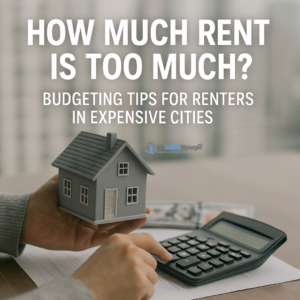In today’s housing market, determining how much rent is too much can be a challenging decision, especially in high-cost urban areas. With rent prices soaring in places like San Francisco, New York, and other metropolitan hubs, many people find themselves questioning how much they should allocate toward housing costs.
A recent discussion on Team Blind sheds light on this issue, with professionals from various industries sharing their experiences and opinions on rent affordability. The debate underscores a crucial question: How much of your income should go toward rent, and at what point does it become unsustainable?
The 30% Rule: A Traditional Approach to Rent Budgeting
One of the most commonly referenced guidelines for rent affordability is the 30% rule. This rule suggests that renters should allocate no more than 30% of their gross income to housing expenses, including rent and utilities.
This guideline has historical roots in U.S. housing policy, dating back to the 1960s and 1970s, when it was introduced to help establish affordability benchmarks. The logic behind this rule is to ensure that renters have enough income left over for other necessary expenses such as food, healthcare, transportation, and savings.
However, while the 30% rule is useful as a benchmark, it may not be realistic for everyone, particularly those living in high-cost-of-living areas. For instance, if you earn $100,000 per year, the 30% rule suggests spending no more than $2,500 per month on rent. In cities like San Francisco, New York, or Los Angeles, finding a comfortable apartment at this price range can be difficult without having roommates or living far from the city center.
Rethinking Rent Affordability: Alternative Budgeting Methods
Since the 30% rule may not work for everyone, many individuals turn to alternative budgeting strategies that provide more flexibility based on personal financial situations and lifestyle choices.
1. The 50/30/20 Rule
The 50/30/20 rule, popularized by Senator Elizabeth Warren, divides after-tax income into three categories:
- 50% for necessities (housing, utilities, groceries, transportation)
- 30% for discretionary spending (entertainment, travel, dining out)
- 20% for savings and debt repayment
Under this rule, rent is bundled together with other essentials, meaning that spending more than 50% on rent and necessities could limit financial flexibility. While this approach is more comprehensive than the 30% rule, it may still be difficult for renters in expensive cities where housing costs alone exceed 50% of income.
2. The 40X Rule for Renters
For those applying for apartments in competitive rental markets, landlords often use the 40X rule to determine affordability. This rule suggests that renters should earn at least 40 times the monthly rent in annual gross income. For example:
- A $3,000/month apartment requires a salary of $120,000 per year.
- A $4,000/month apartment requires a salary of $160,000 per year.
This rule is widely used in cities like New York, where landlords conduct stringent income checks before approving rental applications.
When Are You Paying Too Much for Rent?
While these guidelines provide a rough framework, there are several warning signs that indicate you may be spending too much on rent:
1. You’re Unable to Save Money
If you find that a significant portion of your income goes toward rent and you have little to no savings left at the end of each month, it may be a sign that you’re overspending. Experts generally recommend saving at least 20% of your income for future investments, emergencies, and retirement.
2. You’re Relying on Credit Cards for Daily Expenses
If paying rent leaves you short on cash for essentials like groceries, transportation, or utility bills, and you’re regularly relying on credit cards to cover basic expenses, your rent is likely too high.
3. You Have High Financial Stress
Constantly worrying about making rent payments, struggling to afford unexpected expenses, or feeling trapped in a lease that consumes most of your income are clear signs that you may be overpaying for housing.
How to Make Rent More Affordable
If you’re spending too much on rent, there are several strategies to help reduce housing costs:
1. Consider Getting a Roommate
One of the easiest ways to lower rent expenses is to share a living space with a roommate. Splitting rent and utility costs can cut your expenses by 30-50%, making it easier to stay within a reasonable budget.
2. Negotiate Your Rent
Depending on the market conditions and the landlord’s flexibility, negotiating a lower rent or signing a longer lease term (e.g., 18 months instead of 12) could lead to savings.
3. Look for Rent-Controlled or Subsidized Housing
Some cities offer rent-controlled apartments or government-assisted housing programs for qualifying individuals. If your city has rent stabilization policies, they can help keep costs manageable over time.
4. Relocate to a More Affordable Area
If rent is consuming too much of your income, consider moving to a lower-cost neighborhood or relocating to a nearby city with better affordability. Many professionals are opting for remote work arrangements, allowing them to live in more affordable locations while maintaining their careers.
Final Thoughts: How Much Should You Really Spend on Rent?
Ultimately, the ideal amount to spend on rent depends on your income, lifestyle, and long-term financial goals. While guidelines like the 30% rule or 50/30/20 rule offer useful benchmarks, they aren’t one-size-fits-all.
Instead, focus on balancing affordability with your financial priorities:
- If saving for a house, retirement, or financial independence is a priority, you may want to limit rent expenses as much as possible.
- If living in a prime location is important for career growth and networking, spending a bit more on rent might be justified.
By assessing your unique financial situation and making informed choices, you can find a housing arrangement that meets both your needs and your budget.

